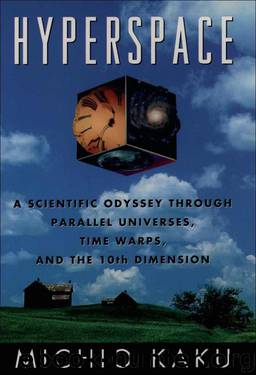Hyperspace by Kaku Michio & O'Keefe Robert

Author:Kaku, Michio & O'Keefe, Robert [O'Keefe, Robert]
Language: eng
Format: epub
Publisher: Oxford University Press, USA
Published: 1994-01-27T07:00:00+00:00
Signals from Outer Space
Since the SSC will never be built, and hence will never detect particles that are low-energy resonances of the superstring, then another possibility is to measure the energy of cosmic rays, which are highly energetic subatomic particles whose origin is still unknown, but must lie deep in outer space beyond our galaxy. For example, although no one knows where they come from, cosmic rays have energies much larger than anything found in our laboratories.
Cosmic rays, unlike the controlled rays produced in atom smashers, have unpredictable energies and cannot produce precise energies on demand. In some sense, it’s like trying to put out a fire by either using hose water or waiting for a rainstorm. The hose water is much more convenient: We can turn it on any time we please, we can adjust the intensity of the water at will, and all the water travels at the same uniform velocity. Water from a fire hydrant therefore corresponds to producing controlled beams in atom smashers. However, water from a rainstorm may be much more intense and effective than water from a fire hydrant. The problem, of course, is that rainstorms, like cosmic rays, are unpredictable. You cannot regulate the rainwater, nor can you predict its velocity, which may fluctuate wildly.
Cosmic rays were first discovered 80 years ago in experiments performed by the Jesuit priest Theodor Wulf atop the Eiffel Tower in Paris. From the 1900s to the 1930s, courageous physicists sailed in balloons or scaled mountains to obtain the best measurements of cosmic rays. But cosmic-ray research began to fade during the 1930s, when Ernest Lawrence invented the cyclotron and produced controlled beams in the laboratory more energetic than most cosmic rays. For example, cosmic rays, which are as energetic as 100 million electron volts, are as common as rain drops; they hit the atmosphere of the earth at the rate of a few per square inch per second. However, Lawrence’s invention spawned giant machines that could exceed that energy by a factor of 10 to 100.
Cosmicray experiments, fortunately, have changed dramatically since Father Wulf first placed electrified jars on the Eiffel Tower. Rockets and even satellites can now send radiation counters high above the earth’s surface, so that atmospheric effects are minimized. When a highly energetic cosmic ray strikes the atmosphere, it shatters the atoms in its wake. These fragments, in turn, create a shower of broken atoms, or ions, which can then be detected on the ground by this series of detectors. A collaboration between the University of Chicago and the University of Michigan has inaugurated the most ambitious cosmic-ray project yet, a vast array of 1,089 detectors scattered over about a square mile of desert, waiting for the cosmic-ray showers to trigger them. These detectors are located in an ideal, isolated area: the Dugway Proving Grounds, 80 miles southwest of Salt Lake City, Utah.
The Utah detector is sensitive enough to identify the point of origin of some of the most energetic cosmic rays. So far, Cygnus X-3 and Hercules X-l have been identified as powerful cosmic-ray emitters.
Download
This site does not store any files on its server. We only index and link to content provided by other sites. Please contact the content providers to delete copyright contents if any and email us, we'll remove relevant links or contents immediately.
The Complete Stick Figure Physics Tutorials by Allen Sarah(7307)
Secrets of Antigravity Propulsion: Tesla, UFOs, and Classified Aerospace Technology by Ph.D. Paul A. Laviolette(5309)
Thing Explainer by Randall Munroe(3877)
The River of Consciousness by Oliver Sacks(3538)
The Order of Time by Carlo Rovelli(3145)
How To by Randall Munroe(3033)
A Brief History of Time by Stephen Hawking(2960)
I Live in the Future & Here's How It Works by Nick Bilton(2935)
The Great Unknown by Marcus du Sautoy(2646)
What If?: Serious Scientific Answers to Absurd Hypothetical Questions by Randall Munroe(2637)
Midnight in Chernobyl by Adam Higginbotham(2483)
Blockchain: Ultimate Step By Step Guide To Understanding Blockchain Technology, Bitcoin Creation, and the future of Money (Novice to Expert) by Keizer Söze(2445)
Networks: An Introduction by Newman Mark(2360)
The Meaning of it All by Richard Feynman(2300)
Easy Electronics by Charles Platt(2281)
The Tao of Physics by Fritjof Capra(2229)
Midnight in Chernobyl: The Untold Story of the World's Greatest Nuclear Disaster by Adam Higginbotham(2177)
When by Daniel H Pink(2082)
Introducing Relativity by Bruce Bassett(2076)
